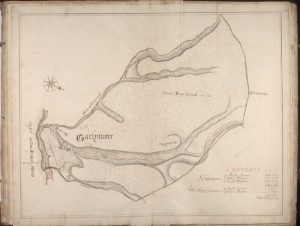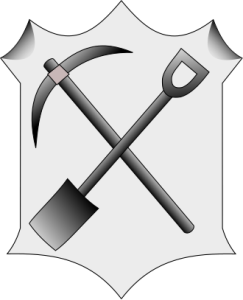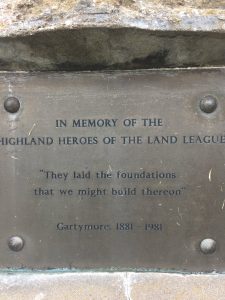George Gunn is a signatory to the 2023 Declaration of Calton Hill. In this thought provoking article, first posted by bella caledonia, George argues that climate activists should take inspiration from the Highland Land League’s slogan “Is treasa tuath na tighearna” (The people are mightier than a lord.) Allan Armstrong adds his own comment at the end.
THE WINDS OF CHANGE AT GARTYMORE
In 1881, a time of landowner tyranny in Sutherland and across the Highlands, Joseph Macleod of Helmsdale was stirred to action. Along with Donald Bannerman of Bual, Donald Watson of Gartymore Shore and John Fraser of A’ Choire, he formed what was termed “a small but resolute brotherhood”, who met almost nightly to lay plans for the restoration of the land to the people. They asked Angus Sutherland, a leading light of the Crofters Party and a future MP, to come to Gartymore and address a public meeting. He agreed and the result was that the first branch of the Sutherland Association was formed. This became the parent of the Highland Land League (Dionnasg an Fhearainn), which soon attracted 15,000 members.
By 1885 the Crofters Party had five MP’s and the following year they had six and so it was in 1886 that Gladstone’s Liberal government passed the Crofters Holdings (Scotland) Act, which applied to crofting tenure, which it described as “an area which is now recognisable as a definition of the Highlands and Islands.” The Act granted real security of tenure to existing crofts and established the first Crofters Commission, which had rent-fixing powers. Rents were generally reduced and 50% or more of outstanding arrears were cancelled. Issues such as limited access to land would have to wait for a future Scottish government to address.
The significance of the Gartymore meeting in 1881 was that it was the first time the crofters had organised themselves and said, “No, we are not going to be subjected to this oppression. It stops here. Now.” They demanded change and took direct action to achieve it. Considering the dire consequences of eviction, starvation and emigration which could rain down on their families courtesy of the Sutherland Estate their courage was remarkable. The Highland Land League’s best known slogan was “Is treasa tuath na tighearna.” This is usually translated as “The people are mightier than a lord.” Gartymore proved that when the people organise there is nothing they cannot achieve. From insurrection comes resurrection.

That lords, sundry aristocrats and various other moneyed individuals, continue to own vast swathes of the Highlands and Islands is evidence that there is still much work to be done on landownership. Despite the fact that the majority of the population of Scotland now live in an urban environment does not change the principle that the land is everything. From how we value land and use it is determined how we as a people value ourselves and how we can create a society where equity and well-being can actually come into being. Vast Highland sporting estates, devoid of people and indirectly subsidised by the majority, prolong poverty. A landscape with no people in it is not a living landscape. It is what Frank Fraser Darling, in his “West Highland Survey: An Essay in Human Ecology” of 1955, called “a wet desert”.
It is capitalism which makes land ownership and sporting use immoral. It does so in two specific ways – through its ability to undermine our motivation to work and to undermine our agency as citizens in a democracy. In Scotland, as it stands, if you have the cash you can buy what you like. Whether it is the borough of Leith or vast swatches of Caithness and Sutherland, everything has its price, everything is property, everything is for sale. When our natural resources, which land is the primary one, are treated as property and can be owned, bought and sold, by an individual or a hedge fund, then our basic democracy falls away because we are in effect powerless and cannot influence or change that paradigm.
In his acceptance speech on being elected First Minister Humza Yousaf told the Scottish Parliament that the “best argument for independence is to make the best possible use of the parliament’s existing powers”. If the Scottish government were to introduce an Annual Ground Rent (AGR) or a Land Value Tax, call it what you like, then we would be a good way down the road to eradicating poverty. Will Humza Yousaf make this a central policy of his new government? The Scottish government could have done it years ago. But they have not. Yet in 2016 AGR was approved at the SNP conference which committed the party to explore the use of land as the principal source of public funding. Even such well known radicals as the International Monetary Fund and The World Bank have published research which shows that land as the source of public funding can be sufficient to fund the government and have also drawn attention to the correlation of landownership to poverty. The Scotland Act of 2016 devolved to the Scottish Parliament the power to tax land and to do so without the interference or consent of Westminster or His Majesties Revenues and Customs. The writer Graeme McCormick has written in The National (12.3.23),
“By taxing land and setting a zero rate for income tax on earned income there would be an explosion of economic activity as vacant and dilapidated land and property were brought back into use. Without a substantial and sustainable increase in our public funds, our public services will never meet our people’s expectation. Our poor don’t have the luxury of waiting till we are independent.”

The ancient Greek historian Polybius wrote in his epic about the Punic Wars, “Those who know how to win are much more numerous than those who know how to make proper use of their victories.”
I wish Humza Yousaf well and that he does make a proper use of his victory. One way to this is to realise that you cannot pick and choose your favourite issues, that everything is connected – land leads on to food production, energy generation and distribution and that without independence we will struggle in Scotland to bring these rising issues to any kind of convergence. Because to the outside eye it appears the Scottish government is not serious about any of this – for example there is not a national data agency to bring all the statistics together in order to formulate policy and run the economy – the UK government will continue to treat our continued and increasingly futile demands for a second referendum with contempt. Let us have our Central Bank and our Scottish currency, for, as the writer Roger Mullin has noted, we cannot “dream our way into independence.” The crofters of Gartymore did not sit and wait for anybody to give them anything. What they achieved they achieved through their own initiative, by direct action and through sheer bravery.
The winds of change for land ownership and use may blow from Gartymore but wind of a different kind blows from Caithness. It is difficult to determine exactly how many wind farms are sited on land in Caithness but according to the Highland Council’s map there are 39. The number of actual turbines is probably ten times that. There is a proposed off-shore wind farm to be constructed north of Forss but the biggest single off-shore array is the Beatrice, off the east Caithness coast, which has 84 turbines and is capable of generating enough electricity to power 450,00 homes. This sea-beat turbine forest is owned by Scottish and Southern Energy Renewable (40%), Red Rock Power Limited (25%), The Renewable Infrastructure Group (17.5%) and Equitix (17.5%). The point here is that the Scottish people own 0% of this mighty enterprise. The Beatrice windfarm pays rent to the Crown Estate which is represented in Scotland through the Crown Estate Scotland, which in turn is managed by the Scottish government and is responsible for the management of land and property in Scotland owned by the monarch ‘in right of the Crown’. In other words the rental accrued from the Beatrice wind farm is a royal “asset”, not a people’s asset. The people of Caithness can only watch all this renewable electricity being generated – and the landlords who own the ground coining in eye watering sums in rent – and then have to buy the energy back at a hugely inflated rate due to transmission charges creamed off by the National Grid.
Earlier in March “Sir” Keir Starmer visited the Beatrice offshore wind farm, along with shadow climate change secretary Ed Miliband and Anas Sarwar. “Sir” Keir Starmer told the press that he has “pledged to use Scotland’s resource to turn the UK into a clean energy superpower.” There was also the usual waffle about 50,000 new jobs in the renewable energy sector over a decade. He conveniently forgot to mention and the British press didn’t ask him about the Labour Westminster government that introduced the transmission charges which contributes to the spiralling energy bills the people of Caithness – and all over Scotland – have to pay.
There is no Scottish National Energy Company so we have no infrastructural purchase and gain no direct benefit from the massive amount of renewable electricity Caithness generates. All the county has become is a flagstone platform which creates wealth for landed individuals and corporations. The people are treated with contempt. We are cows to be milked, encouraged to be politically passive and socially bovine, grazing in the fields we do not own.
Currently the agricultural cash crop in Caithness is barley, for the distilling industry. We grow very little of our own food. In this we are not alone. In 2020 the UK imported 46% of the food consumed. At the recent Scotonomics festival in Dundee Steve Keen, an honorary professor of economics at University College London, said that an independent Scotland must pursue,
“a policy of autarky in food and energy production. If you don’t have food self-sufficiency you’re going to be stuffed and as far as I am aware, Scotland hasn’t got food self-sufficiency, so that’d be my very first policy, you have to build it.”
Autarky is the characteristic of self-sufficiency, usually applied to societies, communities, states, and their economic systems. Which raises the question, just what is sovereignty? National sovereignty is one thing, but what about land sovereignty, food sovereignty, monetary sovereignty and energy sovereignty? My hope is that Humza Yousaf embraces the necessary autarky and puts the Scottish government to work and use the powers they already have in such areas as planning permission and the ability to collect an Annual Ground Rent.
Time is running out. If the Tories, in the coming days, confirm the licensing of the giant Rosemount and Campbell oil fields west of Shetland – as the Guardian has indicated – then all the green policies driven by the Scottish government will come to nothing. There is simply not enough land on the planet to soak up all corporate carbon produced. This is the reality hidden in the slugadh which comes out of the mouth of Douglass Ross. His constant ill-informed and often fictional attacks on the SNP’s record on health and education disguise the deep cynicism of a defender of rentier capitalism and corporate greed and his party’s role in their promotion. When he rises at First Minister’s questions, half linesman-half haggis, the question we have to ask is: what do the unionists offer the people of Scotland? The answer is: they offer them nothing.
In the nineteenth century the Sutherland Estate and their apologists called the crofters of Caithness and Sutherland “savages”. Little did they know that they were the “savages” of civilisation. In 1881 the winds of change blew across Gartymore. These same radical winds can blow across the whole of Scotland. Now.
29.3.23
__________
A comment by Allan Armstrong
The Highland Land League became closely linked to the struggle for Scottish Home Rule. Today with the retreat of the British Empire and Union, the need for Scottish independence is seen as the best way to break such entrenched landed power. And the powerful point George makes that “the people are mightier the the lord”, is also raised in the 2023 Declaration of Calton Hill. It asserts the sovereignty of the Scottish people over the sovereignty of the UK’s Crown-in-Westminster, and the willingness of its signatories to take the action needed to ensure this.
__________
also see:
A flag for a future republic, George Gunn, bella caledonia
This land is your land, this land is my land, Ray Burnett, bella caledonia

